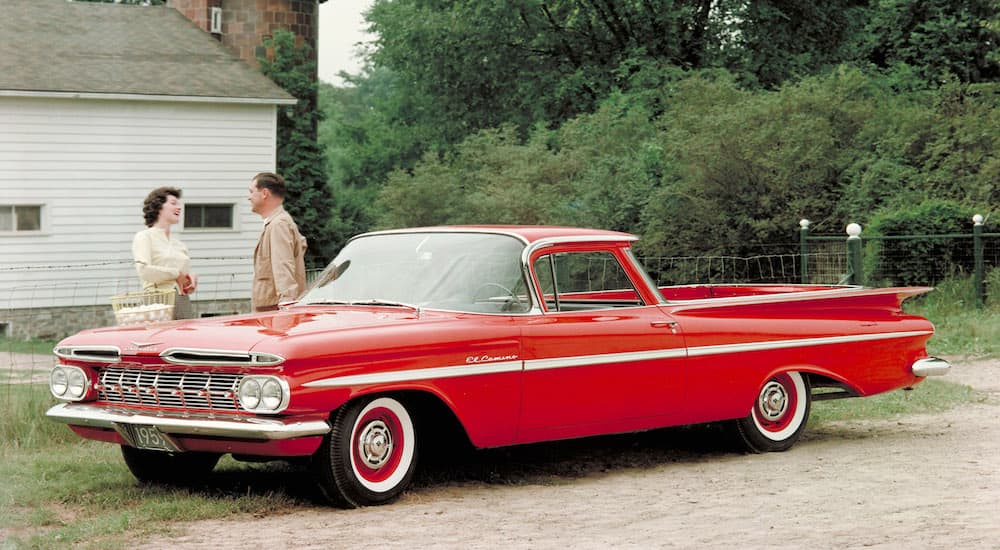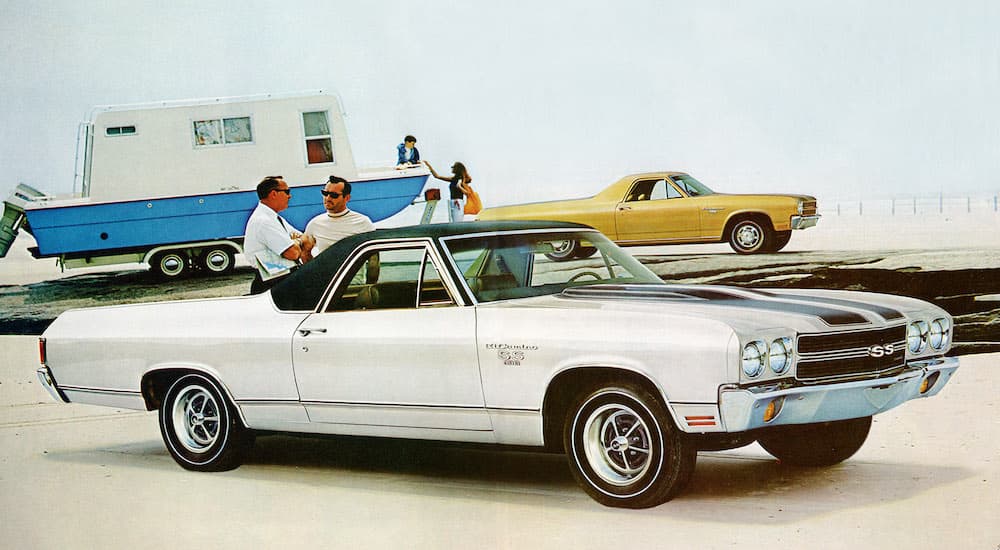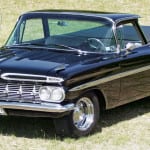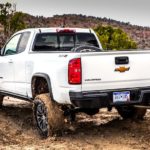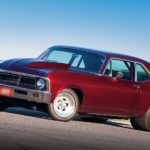With its instantly recognizable style, the Chevy El Camino is a classic worth looking at. A crossbreed of truck and sedan, the Chevy El Camino is a rare sight to behold. If you come across one at your local used Chevy truck dealer, consider yourself lucky. Its distinct styling, muscle car attitude, and pickup truck abilities make the Chevy El Camino a legend amongst enthusiasts. How did such a beloved truck…err car…umm thing, first begin? Let’s take a look and dive into the history of one of the most beloved oddball vehicles out there.
1959 – A Thing is Born
Long before the El Camino ever rolled into our lives, the Australian “ute” entered the scene as one of the first-ever car-truck hybrids. Much like the El Camino itself, legend surrounds the “ute.” It is believed that in the early 1930s, a farmer’s wife realized that she had a need for a vehicle that could be refined enough for church but still be a workhorse for her husband’s farm. She supposedly reached out to a designer at Ford Australia who took on the challenge.
“Ute” is short for a “coupe utility.” Now, much like most things, there is debate as to whether the Australian “ute” was, in fact, the first “coupe utility.” But since we are more interested in the El Camino than the “ute,” we will let you travel that road alone.
Fast-forward 25 years or so to 1957, and Ford debuted its brand-new Ford Ranchero. A “ute” in its own right, the Ranchero was a completely new breed of vehicle for the American market. Its unique design made it popular, resulting in steady sales. Inspired by its relative success, Chevy began designing its own mash-up utility vehicle.
1959 Chevrolet unveiled its all-new El Camino. The El Camino was built using a modified Chevy Brookwood, a full-size station wagon originally released in 1958. The exterior was based on the Bel Air, which was quite a looker itself. The El Camino was marketed for its stylish design and its work-truck capabilities.
One of the ads boasted, “the most beautiful thing that ever shouldered a load!” Which isn’t too far off, considering the Frankenstein parts that went into making this classic monster. With beauty and brawn on its side, the El Camino saw decent sales in the first year of production. However, the first generation didn’t last long and was called to an end after only two years.
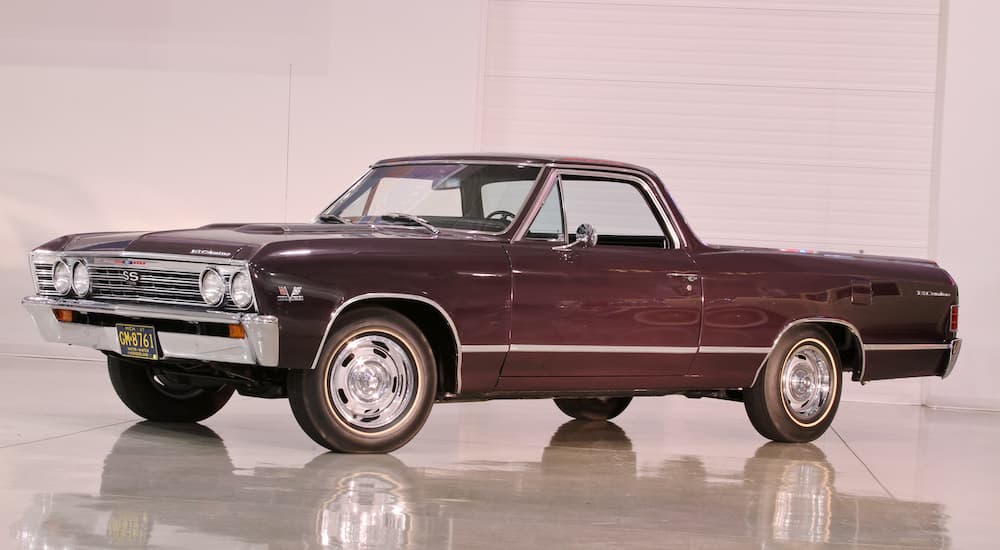
1964 – It Lives…Again
Thankfully, Chevy decided the El Camino was worth another try, in part due to the Ranchero’s continuing success. This time, the El Camino was built on a Chevelle platform. The Chevy Chevelle was a gorgeous midsize high-performance vehicle that would prove to have all the right stuff to be used for the El Camino.
Since the El Camino was using a new platform, the overall appearance and performance had changed a bit. The initial engine options were acceptable but considering the vehicle was so closely related to the Chevelle, people demanded more power. In 1967, the final year of production, a massive 396 cubic inch big-block V8 was added to the lineup.
1968 – Feel the Burn
1968 marked another important evolutionary change for the El Camino. Still using the Chevelle platform, the third-generation El Camino was bulked up. Bigger than ever before, the El Camino needed the power to match. Returning to the big-block roots of the first generation, Chevy offered two large V8 options. The 396 cubic inch option produced a whopping 375 hp, making it more powerful than the first generation. The 454 cubic inch option could produce 450 hp. This was mind-boggling for that era.
Despite the increased size and power, the third-generation El Camino weighed less than the previous models, driving it further into the muscle car category. The El Camino SS certainly lived up to the Super Sport name and was a high-performance machine, blowing the first generation out of the water.
1971 – Same Generation, Different Tune
In 1971, the El Camino, much to the disappointment of gearheads everywhere, was struck by a new mandate. The US government, as part of its initiative for a more sustainable future, required vehicles to use lower-octane fuel. The Clean Air Act would see many amendments over the years, but unfortunately, that did not lessen the impact on the El Camino, which would end its third generation with much less power than before.
Another interesting, perhaps less well-known, El Camino tidbit for the start of the 1970s was that the El Camino was not alone. In an attempt to further capitalize on the success of the El Camino, GMC produced an almost identical vehicle named the Sprint. The GMC Sprint had very few differences, and at first glance, it would be hard to tell that the Sprint was not, in fact, an El Camino.
The Sprint was also built on a Chevelle platform and enjoyed similar engine options but sported different trim and emblems. Beyond that, the GMC Sprint and the Chevy El Camino could be twins. The Sprint saw three generations before it came to an end. Although it is almost identical to the El Camino, surviving GMC Sprints are not as valuable. Of course, if you like the look of the El Camino but don’t need the name that goes along with it, buying an old Sprint is a cost-effective way to own a piece of history.
1973 – New Look, Same Personality
1973 ushered in the fourth-generation El Camino. Out with the muscle car version, the newest El Camino was even beefier than before. Not only was the body redesigned and chunked up, but the overall ride was improved. Increased ground clearance, standard front disk brakes, and an updated interior made 1973 the bestselling El Camino ever.
Minor changes occurred during the rest of this generation’s run. Interior and exterior modifications, additions, and subtractions of engine options. In general, the El Camino remained the vehicle people loved, just with less horsepower, although a downrated version of the 454 cubic inch V8 was still available.
1978 – The Generation to End All Generations
1978 marked the beginning of the end for the El Camino. With the discontinuation of the Chevelle, the El Camino was now based on the Malibu. In came a little more mismatched body styling to create a smaller and less sporty El Camino. A V6 was used for the first time ever in the El Camino, with optional small-block V8 upgrades.
For a few years, diesel engines were offered, but that didn’t last long. Minor changes were made after the initial launch of the fifth generation. But, in general, the El Camino remained the same until its fateful end in 1987. The El Camino production line was moved to Mexico in 1985 to cut costs but changing styles and the emergence of more comfortable pickup trucks brought the legend’s run to an end.
Not Quite the End
Despite the production of the El Camino ending over 25 years ago, it remains a beloved and well-known vehicle. In fact, an El Camino SS 454, fully restored and in mint condition, can easily go for over $100,000. The market for these truly unique vehicles has not disappeared, and those who share a love for the strange “ute” flock together for car meets just to celebrate their love for the thing.
There have even been rumors of a new El Camino based on the SS trim. Of course, that has yet to be substantiated and may be merely a hopeful public looking to see the myth reborn. Whatever the case, the El Camino made a huge impact on the automotive world. The enduring value of these vehicles shows sentimentality can be enough to keep something alive for a very long time.
